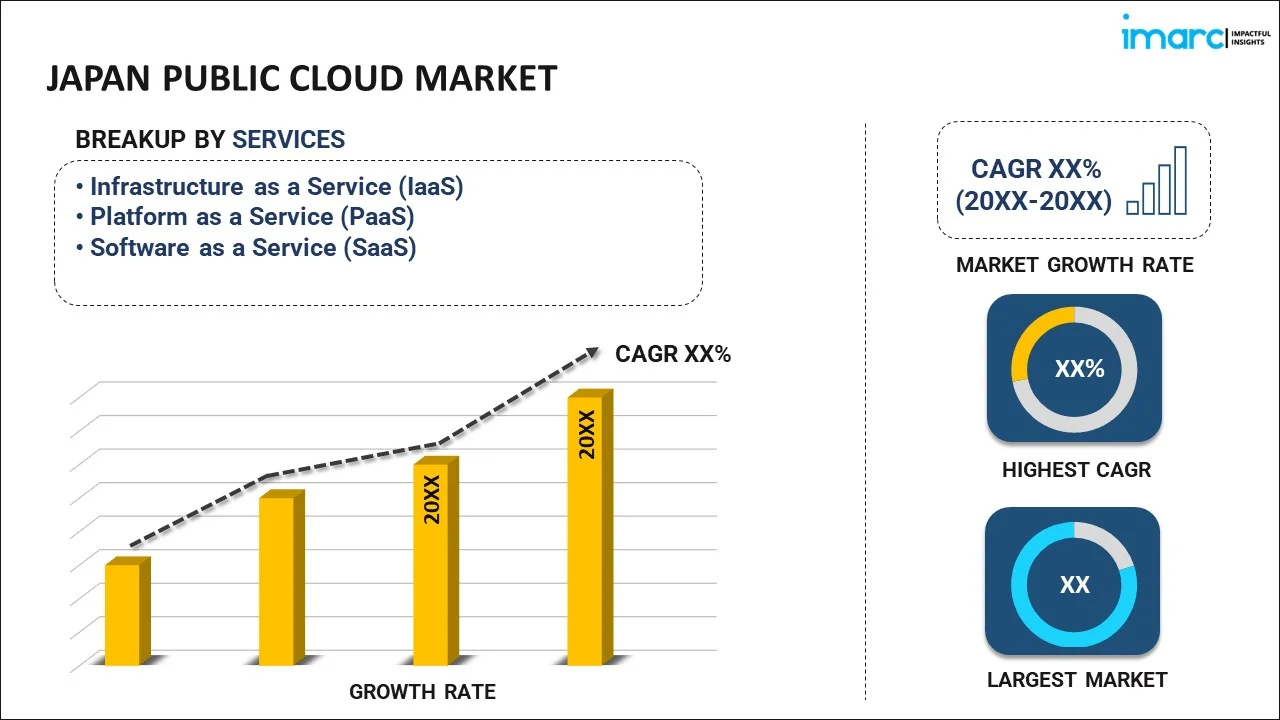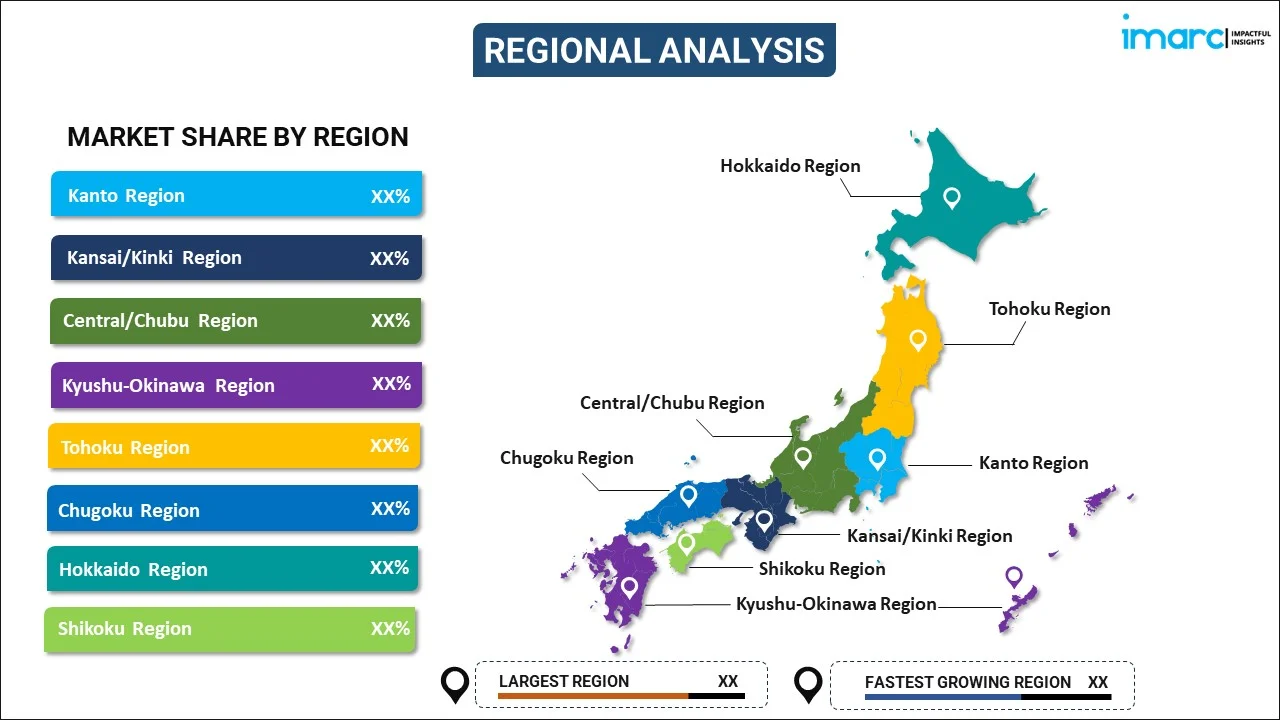
Japan Public Cloud Market Report by Service (Infrastructure as a Service (IaaS), Platform as a Service (PaaS), Software as a Service (SaaS)), Enterprise Size (Large Enterprise, Small and Medium-sized Enterprises), End Use (BFSI, IT and Telecom, Retail and Consumer Goods, Manufacturing, Energy and Utilities, Healthcare, Media and Entertainment, Government and Public Sector, and Others), and Region 2025-2033
Market Overview:
Japan public cloud market size reached USD 50,607 Million in 2024. Looking forward, IMARC Group expects the market to reach USD 146,405 Million by 2033, exhibiting a growth rate (CAGR) of 12.5% during 2025-2033. The increasing demand for Internet of Things (IoT) devices, which generate vast amounts of data that can be efficiently processed and analyzed in the cloud, is primarily driving the market.
|
Report Attribute
|
Key Statistics
|
|---|---|
|
Base Year
|
2024 |
|
Forecast Years
|
2025-2033
|
|
Historical Years
|
2019-2024
|
| Market Size in 2024 | USD 50,607 Million |
| Market Forecast in 2033 | USD 146,405 Million |
| Market Growth Rate (2025-2033) | 12.5% |
A public cloud is a type of cloud computing service offered by third-party providers, like Amazon Web Services (AWS), Microsoft Azure, or Google Cloud Platform (GCP), to organizations and individuals. In a public cloud, computing resources such as servers, storage, and networking are hosted and managed off-site in data centers by the cloud provider. Users can access these resources on a pay-as-you-go basis, allowing for scalability and flexibility. Public clouds offer numerous benefits, including cost-efficiency, as users only pay for the resources they use. They also provide access to a wide range of services and technologies, enabling businesses to innovate and deploy applications rapidly without the need for significant upfront investments in infrastructure. Additionally, public clouds often boast high levels of security and reliability due to the expertise and resources of the cloud providers. However, users must share the cloud infrastructure with other customers, which can raise security and compliance concerns.
Japan Public Cloud Market Trends:
The growth of the public cloud market in Japan is driven by several key factors. Firstly, the increasing demand for scalable and cost-effective computing solutions has fueled its expansion. As organizations strive to optimize their IT infrastructure, they turn to public cloud services to avoid the substantial capital expenditure associated with on-premises hardware and maintenance. Furthermore, the proliferation of remote work and the need for flexible, accessible data storage and processing have accelerated the adoption of public cloud solutions. In addition to these factors, the relentless pace of technological innovation plays a crucial role in propelling the public cloud market forward. Providers continually enhance their offerings, incorporating cutting-edge technologies like artificial intelligence, machine learning, and data analytics into their platforms. This not only attracts new customers but also encourages existing ones to expand their usage of cloud services. Lastly, regulatory compliance and data security concerns have prompted organizations to seek reputable public cloud providers with robust security measures and compliance certifications. This, in turn, is expected to drive the public cloud market in Japan, pushing providers to continually enhance their security features to meet evolving customer demands.
Japan Public Cloud Market Segmentation:
IMARC Group provides an analysis of the key trends in each segment of the market, along with forecasts at the country level for 2025-2033. Our report has categorized the market based on service, enterprise size, and end use.
Service Insights:

- Infrastructure as a Service (IaaS)
- Platform as a Service (PaaS)
- Software as a Service (SaaS)
The report has provided a detailed breakup and analysis of the market based on the service. This includes infrastructure as a service (IaaS), platform as a service (PaaS), and software as a service (SaaS).
Enterprise Size Insights:
- Large Enterprise
- Small and Medium-sized Enterprises
A detailed breakup and analysis of the market based on the enterprise size have also been provided in the report. This includes large enterprise and small and medium-sized enterprises.
End Use Insights:
- BFSI
- IT and Telecom
- Retail and Consumer Goods
- Manufacturing
- Energy and Utilities
- Healthcare
- Media and Entertainment
- Government and Public Sector
- Others
The report has provided a detailed breakup and analysis of the market based on the end use e. This includes BFSI, IT and telecom, retail and consumer goods, manufacturing, energy and utilities, healthcare, media and entertainment, government and public sector, and others.
Regional Insights:

- Kanto Region
- Kansai/Kinki Region
- Central/ Chubu Region
- Kyushu-Okinawa Region
- Tohoku Region
- Chugoku Region
- Hokkaido Region
- Shikoku Region
The report has also provided a comprehensive analysis of all the major regional markets, which include Kanto Region, Kansai/Kinki Region, Central/ Chubu Region, Kyushu-Okinawa Region, Tohoku Region, Chugoku Region, Hokkaido Region, and Shikoku Region.
Competitive Landscape:
The market research report has also provided a comprehensive analysis of the competitive landscape in the market. Competitive analysis such as market structure, key player positioning, top winning strategies, competitive dashboard, and company evaluation quadrant has been covered in the report. Also, detailed profiles of all major companies have been provided.
Japan Public Cloud Market Report Coverage:
| Report Features | Details |
|---|---|
| Base Year of the Analysis | 2024 |
| Historical Period | 2019-2024 |
| Forecast Period | 2025-2033 |
| Units | Million USD |
| Scope of the Report | Exploration of Historical and Forecast Trends, Industry Catalysts and Challenges, Segment-Wise Historical and Predictive Market Assessment:
|
| Services Covered | Infrastructure as a Service (IaaS), Platform as a Service (PaaS), Software as a Service (SaaS) |
| Enterprise Sizes Covered | Large Enterprise, Small and Medium-sized Enterprises |
| End Uses Covered | BFSI, IT and Telecom, Retail and Consumer Goods, Manufacturing, Energy and Utilities, Healthcare, Media and Entertainment, Government and Public Sector, Others |
| Regions Covered | Kanto Region, Kansai/Kinki Region, Central/ Chubu Region, Kyushu-Okinawa Region, Tohoku Region, Chugoku Region, Hokkaido Region, Shikoku Region |
| Customization Scope | 10% Free Customization |
| Post-Sale Analyst Support | 10-12 Weeks |
| Delivery Format | PDF and Excel through Email (We can also provide the editable version of the report in PPT/Word format on special request) |
Key Questions Answered in This Report:
- How has the Japan public cloud market performed so far and how will it perform in the coming years?
- What has been the impact of COVID-19 on the Japan public cloud market?
- What is the breakup of the Japan public cloud market on the basis of service?
- What is the breakup of the Japan public cloud market on the basis of enterprise size?
- What is the breakup of the Japan public cloud market on the basis of end use?
- What are the various stages in the value chain of the Japan public cloud market?
- What are the key driving factors and challenges in the Japan public cloud?
- What is the structure of the Japan public cloud market and who are the key players?
- What is the degree of competition in the Japan public cloud market?
Key Benefits for Stakeholders:
- IMARC’s industry report offers a comprehensive quantitative analysis of various market segments, historical and current market trends, market forecasts, and dynamics of the Japan public cloud market from 2019-2033.
- The research report provides the latest information on the market drivers, challenges, and opportunities in the Japan public cloud market.
- Porter's five forces analysis assist stakeholders in assessing the impact of new entrants, competitive rivalry, supplier power, buyer power, and the threat of substitution. It helps stakeholders to analyze the level of competition within the Japan public cloud industry and its attractiveness.
- Competitive landscape allows stakeholders to understand their competitive environment and provides an insight into the current positions of key players in the market.
Need more help?
- Speak to our experienced analysts for insights on the current market scenarios.
- Include additional segments and countries to customize the report as per your requirement.
- Gain an unparalleled competitive advantage in your domain by understanding how to utilize the report and positively impacting your operations and revenue.
- For further assistance, please connect with our analysts.
 Inquire Before Buying
Inquire Before Buying
 Speak to an Analyst
Speak to an Analyst
 Request Brochure
Request Brochure
 Request Customization
Request Customization




.webp)




.webp)












